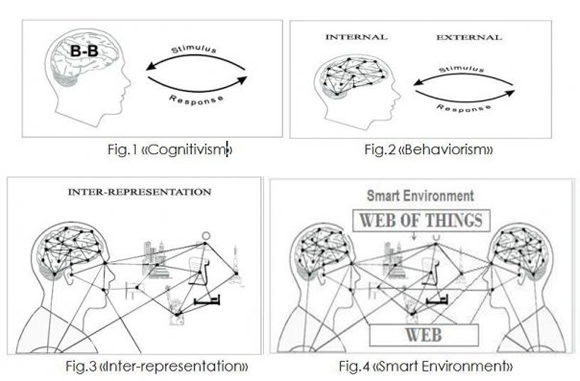Connecting the socio-cultural,economic and transcendent dimensions of Human Enhancement and Smart Environment.
Smart Landscapes City Game Social Network
New trends of NBIC-convergence, Human Enhancement Technologies on the one hand and Smart Environment (Ambient intelligence, Ubiquitous computing, Internet of Things) on the other prepare us to a future paradigm shift blurring Anthropology and Social Philosophy borderlines.
According with Juval Portugali «The Seven Basic Propositions of SIRN» (Synergetic Inter-RepresentationNetworks): The issue of the boundaries of the cognitive system touches upon the behaviorism-cognitivism historical controversy. Behaviorism (Fig.2) suggested understanding cognitive phenomena in terms of the relations between stimuli and responses in the external environment .
That is, in terms of external representations only, with the mind/brain considered as a blackbox (B-B). Cognitivism (Fig.1) suggests the exact opposite: cognitive phenomena must be understood in terms of internal processes and representations, treating stimulus-response relations as means to reveal processes inside the mind/brain . In both the mind/brain with its internal representations, and the environment with its external representations, are perceived as two essentially independent and causally related, entities. SIRN suggests perceiving the boundaries of the cognitive system, that is, to treat the behaviorist and cognitivist perceptions as two aspects of a single, integrated, inter-representational network (Fig.3). Note that unlike behaviorism that considered bodily external representations only, the SIRN system proposed here includes also artifactual representations. The suggestion to include artifacts within the boundaries of the cognitive goes back to Vygotsky. According to him, signs, tools, activities, or artifacts, as Cole prefers to call them, are all integral elements of the cognitive system by virtue of their role as mediators in higher psychological processes.
We add to Portugali Inter-representation scheme (Fig.3) following elements (Fig.4):
1. WEB («Classic» Internet) with person’s re-presentations (blogs, social nets…). It’s interesting that modern WEB
consist of re-presentations not only living people. We can speak about WEB like as Human Culture representation.
2. WEB OF THINGS (Internet of things) with RFID technology is an active communicative field, where person’s re-presentations actualize through the «Classic» Internet
3. OTHER with a pattern of Inter-representation with YOU and !SELF! (remember K. Pribram Holographic Brain) So our Inter-representation network is synergetic (SIRN), with OTHER and Internet of Things our Smart Environment (Fig.4) is a communicative (N. Luman) cybernetic system of second order (G.Bateson) with complexity effects.
From Smart Environment situation (Fig.4) we expect only one step to the posthuman condition signed Smart Landscape:
Integral synergy approach to the socio-cultural, transcendent and economic dimensions of Emerging and Human Enhancement Technologies (NBIC-convergence, and Smart Environment) can be provided by new Smart Landscape concept.
Smart Landscape is a Posthuman Body meta-form: extrapolation of Person Topology to a real interactive autopoetic Environment Space for Other. So Smart Landscape is Posthuman Being topological self-representation and self-actualization, where he constructs his Body as a social space to another postanthropological Person.
